If you’ve been researching best rhinoplasty in Turkey, you’ve probably noticed the same pattern: people aren’t just coming here for lower prices, they’re coming because they’ve seen noses that look believable. Soft edges. Balanced bridges. Profiles that match the person, not a trend. This is what Istanbul is known for in the rhinoplasty world. Not dramatic change, harmony.
Walk into a consultation here and the tone is usually calm. The surgeon studies your face in motion, not only in still photos. They’ll talk about breathing, cartilage support, skin thickness, and how your nose interacts with your eyes, lips, and jawline. The goal isn’t to copy someone else’s features, it’s to shape a nose that could have always been yours.
According to ISAPS global procedure reports, rhinoplasty remains one of the most frequently performed cosmetic surgeries in Turkey, with Istanbul being one of the main centers. And the Ministry of Health requires surgeons treating international patients to be licensed and operate in approved medical facilities, which is a reassurance many travelers appreciate once they understand how to verify it.
But here’s where most people get stuck:
- How do you know which surgeon is right for your face?
- How long should you stay in Istanbul for safe recovery?
- Is ultrasonic (piezo) rhinoplasty actually better, or just newer?
- How do you confirm a clinic is officially authorized?
Our guide answers those questions directly, without pressure or sales tone. We’ll cover:
- How to verify surgeons and clinics properly
- Best rhinoplasty surgeons in Turkey
- Realistic cost ranges and what they include
- Differences between open, closed, and ultrasonic techniques
- What the first weeks of healing look like day-to-day
- When to move forward and when to pause
Take your time here. Let’s make sure the decision feels clear and grounded, not stressful.
At a Glance: Rhinoplasty in Turkey 2026
- Turkey is home to a good number of skilled surgeons with board certificates and years of experience.
- A good of JCI-accredited facilities, you won’t have to wait any longer to receive your treatment in Turkey than in other European countries or the United States.
- While Turkey is one of the most visited countries for rhinoplasty in the world, all those experts automatically becomes very experienced from month to month.
- Majority of the clinics and surgeons offer all-inclusive packages including surgery, accommodation, transportation, and often post-operative care and medications.
- Look in major cities like Istanbul, Ankara, Antalya and Izmir.
- Open and Closed Rhinoplasty are the most preferred methods.
- The average cost of a rhinoplasty in Turkey is between $2,200 and $4,500, offering great savings when compared to Western countries, UK, and US.
- Most visitors stay 7 to 10 days after surgery for follow-up checks and flight clearance.
- Final result appears slowly over 6 to 12 months as swelling settles.
- Success rate is very high, due to skilled surgeons and advanced practices.
- You can verify clinic and surgeon authorization through HealthTürkiye and USHAŞ.
Surgery & Recovery
- Surgery Duration: 2 to 6 hours
- Anesthesia: General Anesthesia
- Risks: Surgical complications, breathing difficulties, aesthetic concerns, and individual healing variations.
- Hospital Stay: 1 day
- Time Off Work: 2 weeks
- Resuming Exercise: After 6 weeks
- Full Recovery: 6 to 8 weeks
- Post-Surgery Washing: After 1 day, keeping the area dry
- Sleeping Position: On back for at least 4 weeks
The Rhinoplasty Procedure: What the Process Actually Feels Like
Rhinoplasty isn’t a single moment in the operating room. It’s a sequence, conversations, planning, a quiet surgery day, and then a slow settling period where your face and mind adjust together.
It usually begins with a consultation, either online or in person. You and your surgeon look at your nasal structure, breathing, skin thickness, and the way your features relate to each other. This is where the shape goals are formed, not from a trend photo, but from your own proportions.
During surgery, you’re under general anesthesia, so you don’t feel or remember anything. Most procedures last between 1 to 3 hours, depending on structure and whether the surgeon is working open or closed. The approach is chosen based on your anatomy, not preference alone.
In the first few days after surgery, swelling and some bruising are normal. Most people describe the sensation more like pressure or fullness than pain. By day 7 to 10, many people feel comfortable enough to be out in the city, at the airport, or back at work (virtual or in-person).
But the deeper part of healing is slower. The nose shape refines gradually:
- First month: the framework softens
- 3–6 months: tip definition becomes clearer
- 6–12 months: the final contour settles
There is nothing to “hurry”. A natural rhinoplasty lets the result appear softly over time.
Wanna learn more about “What is Rhinoplasty? from Procedure to Recovery and Costs“?
Who Is Considered a Good Candidate for Rhinoplasty?
Rhinoplasty works best for people who want refinement, not a completely different identity. A good candidate usually:
- Has fully developed facial features (typically age 16–18+ depending on natural growth)
- Is in generally good health
- Feels clear about why they want the change
- Understands that healing takes months, not days
- Is willing to avoid smoking before and after surgery, because it affects recovery
The emotional part is important too. The change should be for you, not pressure from outside.
Assoc. Prof. Dr. Güncel Öztürk: “When the intention is clarity and quiet confidence, the result tends to look the most natural.”
Wanna learn more about “Who is a Good Candidate for Rhinoplasty“?
Possible Risks of Rhinoplasty
All surgical procedures carry risk, but rhinoplasty has specific concerns:
- Excessive swelling and bruising
- Asymmetry or overcorrection
- Difficulty breathing (if cartilage or septum healing is suboptimal)
- Scar visibility in open rhinoplasty
- Revision need if healing doesn’t go as planned
Most patients recover without issues when they follow their surgeon’s instructions, attend all follow-ups, and avoid strain, alcohol, or heat exposure during healing.
Why People Choose Rhinoplasty in Turkey
When someone chooses to travel for rhinoplasty, it’s usually not about chasing trends. It’s about finding a place where the surgeon’s eye, the communication style, and the post-operative support feel steady. Istanbul has become that place for many people.
Experienced Surgeons Who Work With Many Different Nose Types
Turkey sees a wide range of nasal shapes, skin thicknesses, and facial structures. This exposure matters. It means surgeons here develop a high level of familiarity with:
- Thicker or oilier skin
- Softer cartilage structures
- Wide nasal bases
- Previous surgical changes (revision cases)
- Ethnic features that carry identity and expression
This is why many international patients feel understood here rather than reshaped.
Assoc. Prof. Dr. Güncel Öztürk: “A nose should belong to your story, not erase it.”
Clear Communication and Step-by-Step Guidance
Most clinics that treat international patients have dedicated coordinators who:
- Explain the process in simple language
- Answer questions quickly
- Guide you through aftercare
- Stay in touch long after you fly home
This steady messaging support is one of the reasons patients feel held, not just treated.
Calm Recovery Environment
A short walk by the Bosphorus. A quiet café corner. Warm soup and soft light in the hotel room. Istanbul has a pace that supports healing. You don’t have to “do” much. The city lets you rest without feeling isolated.
Cost That Makes the Decision Less Heavy
The price difference compared to the US, UK, Canada, Ausralia and Gulf region is real, but the reason isn’t lower quality, it’s the healthcare system structure and cost of living. You can work with a skilled surgeon without financial strain. This gives space to choose based on fit, not fear.
A Culture That Treats Care With Warmth
Most patients describe their experience here with one word: Ease. Clinic staff call to check how you slept. Nurses take time without rushing. You are spoken to like a person, not a case.
Istanbeautiful team: “People come here for results. They return for how they were treated.”
What “Best Rhinoplasty in Turkey” Actually Means
People often search for the best surgeon, as if there is one single answer. But noses are not the same. Skin thickness differs. Cartilage strength differs. Taste differs. What looks natural on one face can look out of place on another. So the question shifts from “Who is the best?” to “Who understands the look you want and can explain it clearly?”.
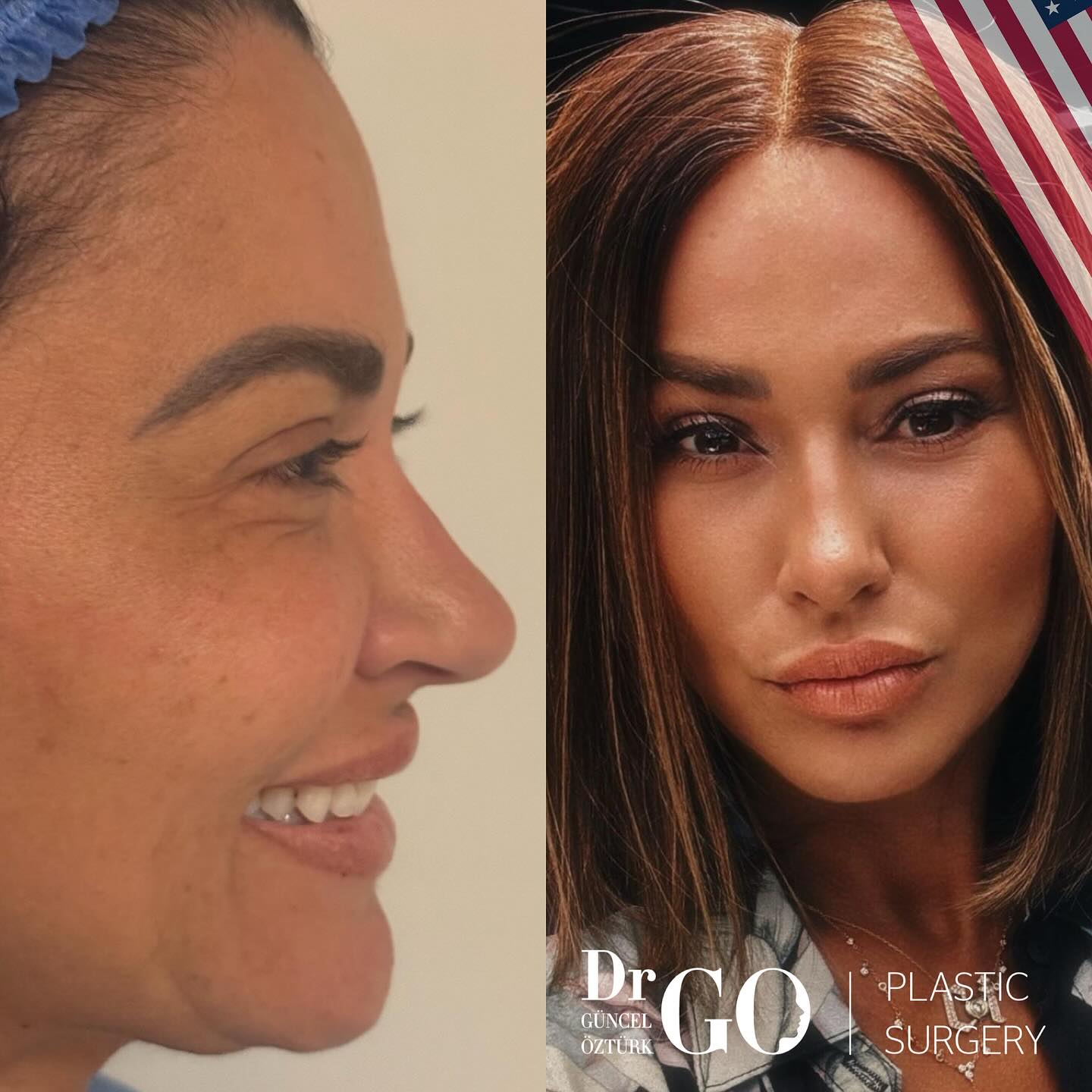
In Istanbul, many surgeons focus almost entirely on rhinoplasty. They study facial balance first, not just the nose alone. The goal is usually quiet harmony: a nose that sits in the background, not the highlight of the face.
According to ISAPS procedure reporting, Türkiye remains one of the most active regions for rhinoplasty. The experience comes from repetition, teaching, and daily practice. But experience alone does not decide fit. Style does.
You can see style in three places:
- How the surgeon shapes the tip
- How they handle the bridge height
- How they talk about breathing and airflow, not just appearance
The conversation matters. If you feel heard, not rushed, you’re closer to the right match.
Assoc. Prof. Dr. Güncel Öztürk: “A well-done rhinoplasty should disappear into the face. If the nose is the first feature someone notices, the intention has been lost.”
There is also the practical side. A real rhinoplasty surgeon will:
- Give their full name without hesitation
- Tell you where the surgery takes place (licensed facility, not a clinic room)
- Show multiple cases of similar nose types to yours
- Talk about healing over months, not quick transformation
According to the Republic of Türkiye Ministry of Health, clinics treating international patients must hold an International Health Tourism Authorization Certificate. This is not a small detail. This is the difference between a safe surgical setting and a guess.
The “best” rhinoplasty in Turkey is not about fame, trending results, or perfect photos. It’s when the final shape feels like it always belonged to your face. That feeling of familiarity, that’s the true goal.
Where to Get Rhinoplasty in Turkey: Best Cities
Turkey has several cities known for rhinoplasty, but each offers a different atmosphere and style of care. Your choice isn’t just about hospitals, it’s about the environment you’ll be healing in.
Istanbul
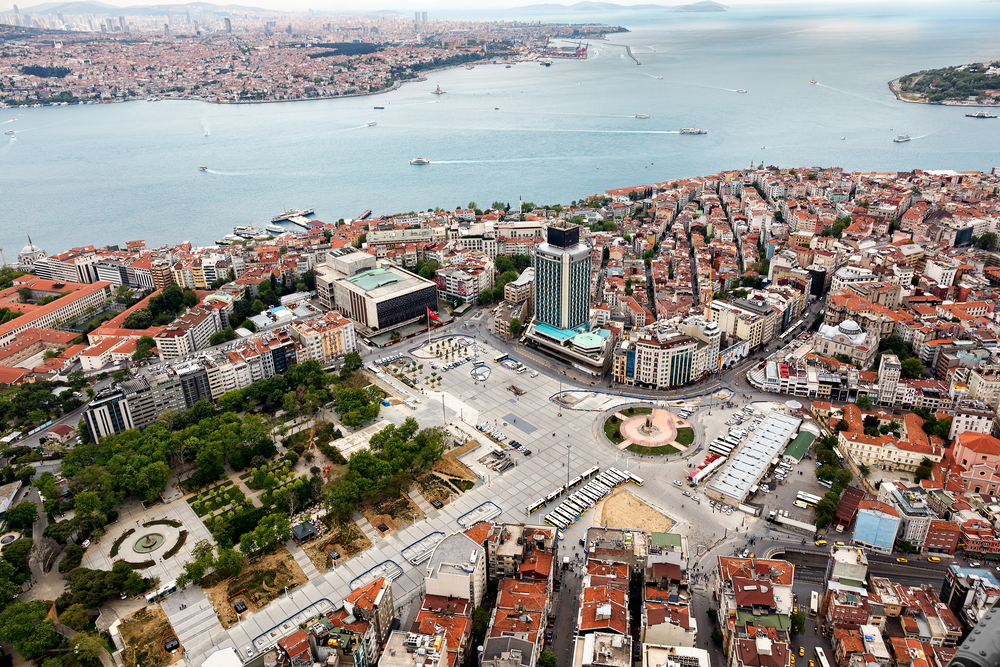
The center of rhinoplasty in Turkey. This is where you’ll find the highest number of experienced plastic surgeons, clinics with international patient programs, and hospitals equipped for complex and revision cases. Istanbul is also where communication support tends to be strongest, since many clinics work daily with visitors from Europe, the Gulf, the UK, and the U.S.
Recovery here is easy with short walks by the water, quiet cafes, and easy transportation make the first week feel gentler.
Best for:
- Primary rhinoplasty
- Revision rhinoplasty
- Ultrasound / Piezo techniques
- Patients who want more surgeon options before choosing
Ankara
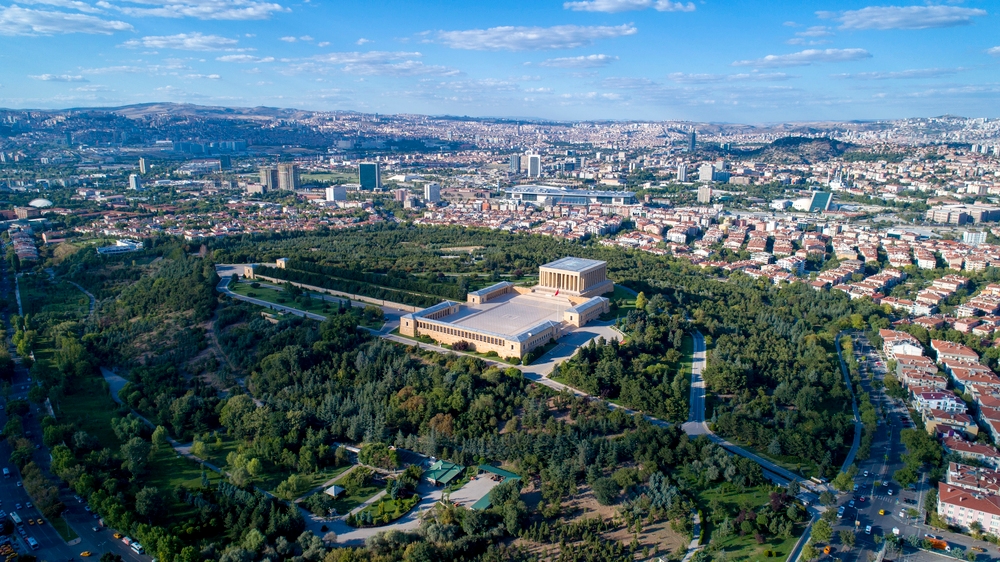
The capital has a calmer medical environment and many surgeons linked with university hospitals. It’s a good place if you value a clinical, calm, less tourist-filled atmosphere. Clinics here tend to be more reserved, slower-paced, and research-oriented.
Best for:
- Patients who prefer a quiet recovery
- Those looking for university-affiliated surgeons
- People who want fewer distractions
Izmir
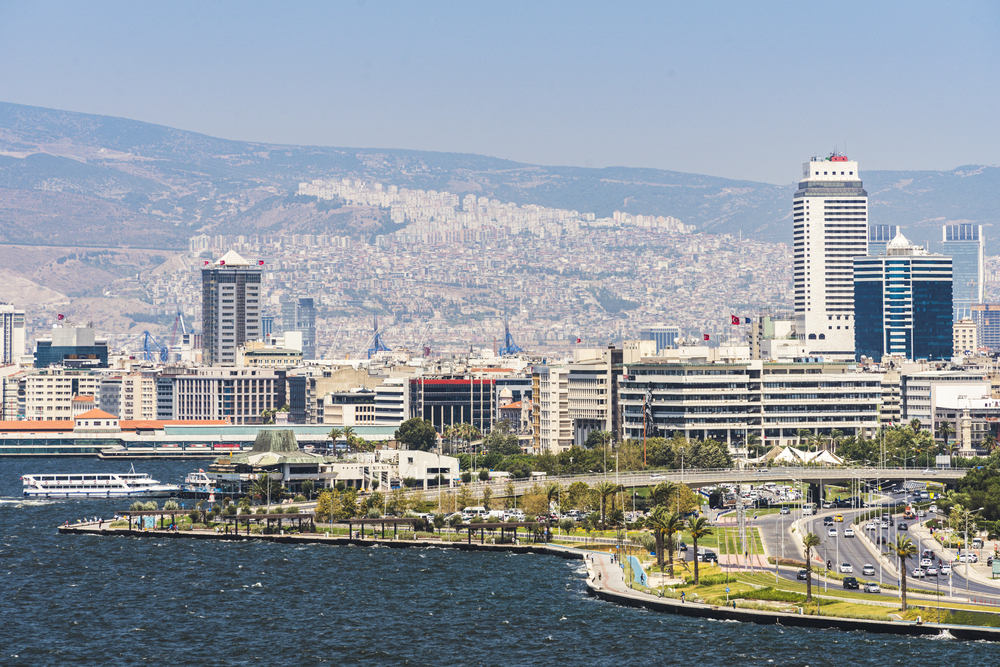
A coastal city with a lighter pace. It feels friendly, relaxed, and easy to navigate. Clinics here may be smaller than Istanbul’s, but many surgeons work with facial balance in a gentle, natural way. Recovery near the sea can feel grounding.
Best for:
- Patients who want a softer, slower environment
- Simple primary rhinoplasty cases
- Travelers who like calm, warm-weather city life
Antalya
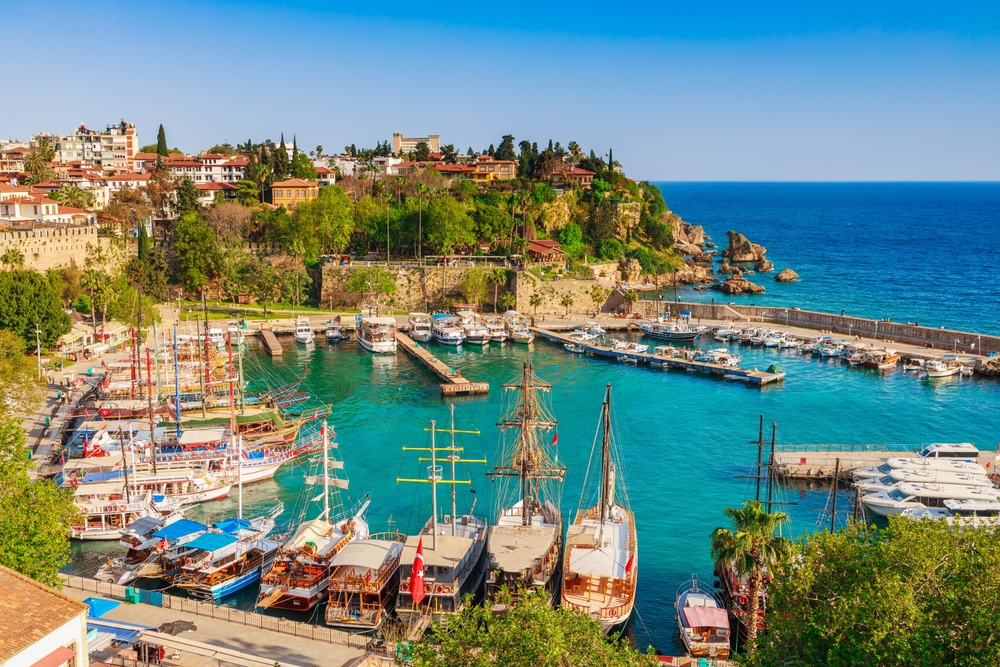
Known primarily for medical tourism combined with resort-style stays. Surgeons here vary widely in experience, so research is important. For some, the combination of sun + sea + recovery feels right, for others, it may feel a bit too vacation-like.
Best for:
- Patients who want privacy in a hotel setting
- A quieter, hotel-based recovery
- Warm climate year-round
Istanbeautiful team: “The right city is the one where your body feels at ease. Your recovery environment matters just as much as the surgery day.”
Quick Safety Checks (5 Minutes)
This part is simple and clear. You don’t need medical knowledge to do it. You only need the correct links and a few details. These checks help you understand whether a clinic is set up to treat international patients safely, not just advertise online.
Step 1: Confirm the Clinic’s Authorization
Clinics in Turkey that treat international patients must hold an International Health Tourism Authorization Certificate issued by the Ministry of Health.
To check this:
- Go to healthturkiye.com
- Search the clinic, hospital by its full legal name
- Make sure the address matches the one on their website
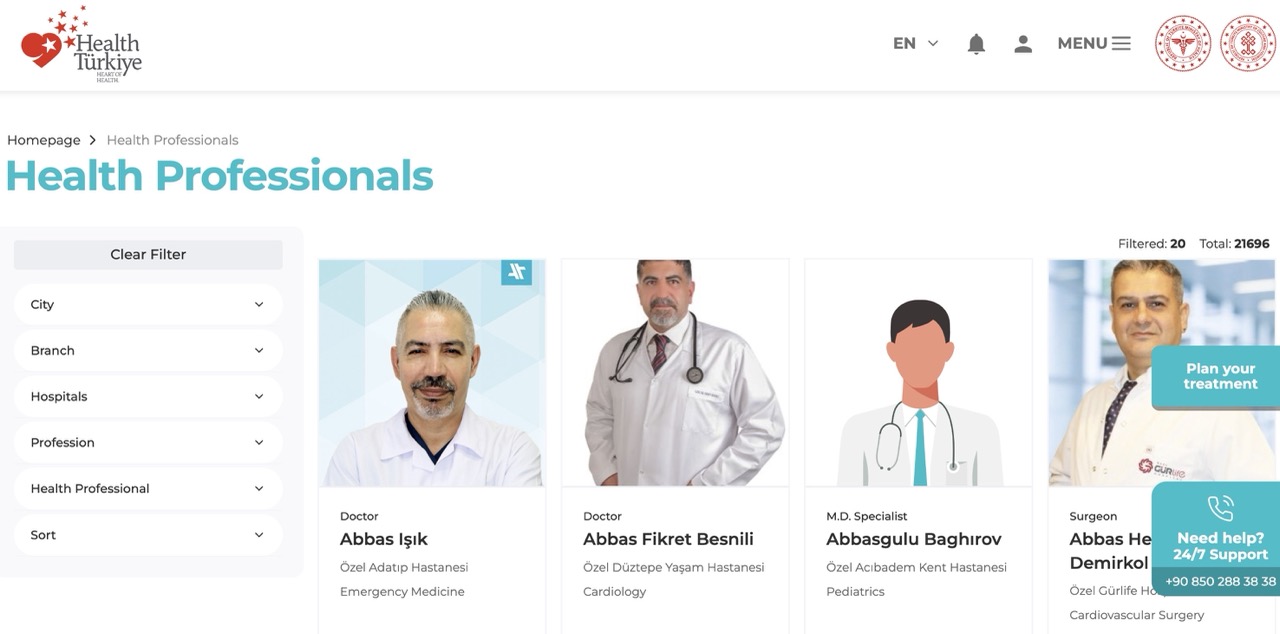
For “Facilitators with International Health Tourism Authorization Certificates”, find them on healthturkiye.com. It can be hard to search but you are getting familiar.
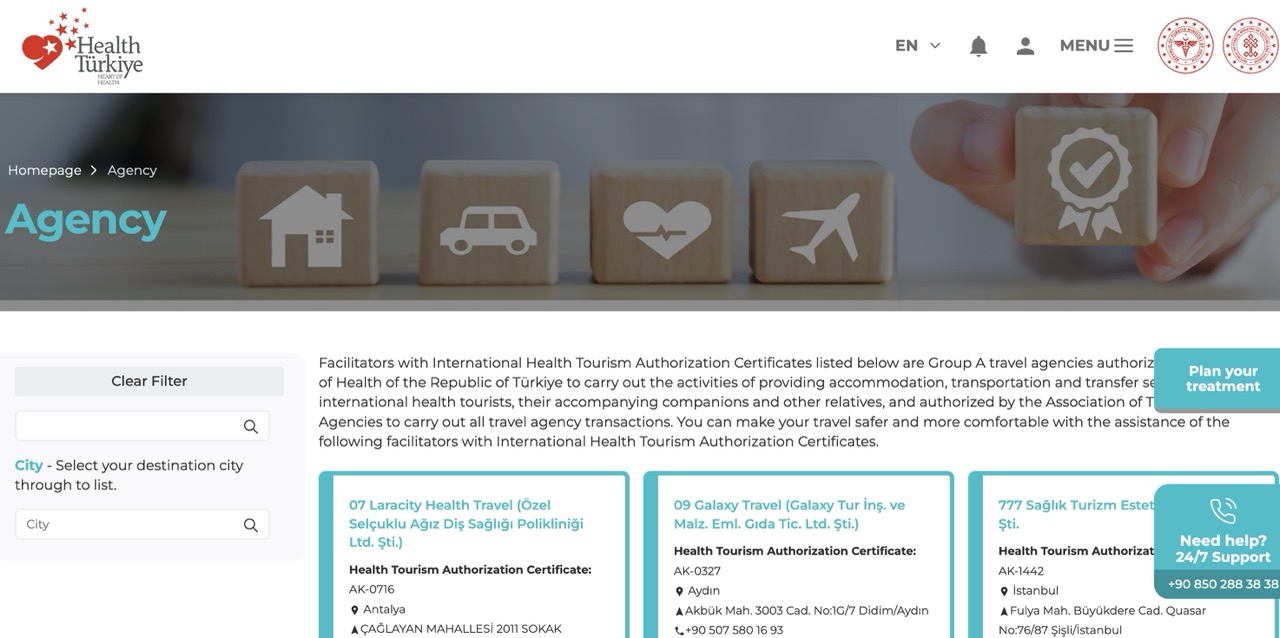
If the clinic does not appear in the system, skip it. If the name appears slightly different than advertised, look carefully. Authorized clinics always match exactly.
Step 2: Verify the Surgeon’s Identity
Ask the clinic for:
- Surgeon’s full legal name
- Their specialty (it should be Plastic, Reconstructive and Aesthetic Surgery)
- Where they completed training
Then, check the surgeon on:
- Healthturkiye.com professional registry
- turkplasticsurgery.org (Turkish Society of Plastic, Reconstructive and Aesthetic Surgeons) or EBOPRAS members
If the clinic gives a coordinator name but refuses to give the surgeon’s name, stop. If the surgeon is real, they will be easy to verify.
Assoc. Prof. Dr. Güncel Öztürk: “The surgeon who plans your operation should be the same surgeon who performs it. That continuity is part of the result.”
Step 3: Confirm Where the Surgery Takes Place
Rhinoplasty is not performed inside office clinics. It should take place in a licensed hospital or a licensed surgical center.
You can ask one simple question: “What is the full name of the hospital where surgery will be performed?”. If the clinic says: “Do not worry, we will tell you later”, walk away.
Step 4: Look for Calm Communication
Rushed messages, countdown offers, “limited-time discounts” or pressure to fast-track surgery are signs to pause.
This whole verification process takes less than five minutes. Once these pieces are in place, the rest of the journey becomes much smoother.
Our Picks: Top Rhinoplasty Surgeons in Turkey
You can find our picks of the best rhinoplasty surgeons in Turkey from our guide page below. Our guide provides information based on their procedures, prices, and reviews. Fell free to check the best surgeons there.
Best Rhinoplasty Surgeons in Istanbul, Turkey
Rhinoplasty Cost in Turkey: Price Ranges, Packages & What’s Included
One of the reasons rhinoplasty in Turkey draws patients from around the world is the combination of experienced surgeons and costs that feel accessible. But “affordable” doesn’t mean rushed or low quality when you choose a licensed clinic and a surgeon who works slowly and carefully.
Rhinoplasty in Turkey typically costs between $2,000 and $5,800 for primary procedures. The exact price depends on the surgeon’s experience, the surgical technique (open, closed, or ultrasonic), and whether the case is primary or revision. Revision rhinoplasty usually ranges from $4,500 to $9,000 because it requires more reconstruction and planning.
Typical Price Range in Istanbul
| Type of Rhinoplasty | Average Cost |
|---|---|
| Primary Rhinoplasty | $2,000 – $4,500 |
| Ultrasonic Rhinoplasty | $3,200 – $5,800 |
| Revision Rhinoplasty | $4,500 – $9,000 (depending on complexity) |
| Ethnic Rhinoplasty | $3,000 – $6,200 |
(Data cross-referenced from ISAPS, TÜİK, Forbes Health, and Turkish Plastic Surgery Association, 2025.)
For comparison:
- UK / EU: $6,500 – $14,000
- USA / Canada: $8,000 – $22,000
- Gulf Region: $7,500 – $16,000
Patients save between 60–70% compared to the U.K. or U.S., where equivalent procedures average $8,000–$12,000.
Turkey isn’t cheaper because the medical care is lower quality. The difference is the healthcare structure and cost of living, surgeons here don’t pass high operational costs on to patients.
What’s Usually Included in a Rhinoplasty Package?
Most licensed clinics offer all-inclusive arrangements, which often include:
- Pre-surgery consultation (online + in person)
- Blood tests and anesthesiology examination
- Surgery fees + hospital or surgical center
- Post-op medications
- Splint removal and follow-up visits
- 5–10 nights in a hotel
- Private driver for airport & clinic transfers
- Translation / patient coordinator support
- Ongoing messaging follow-ups after you return home
The main point is who is performing the surgery, not the hotel décor or driver. A steady surgeon is the real value.
Istanbeautiful team: “When comparing prices, compare the surgeon’s hands, not the package extras.”
Why Some Clinics Are Much Cheaper
Prices drop sharply when:
- The surgery is done by an assistant, not a specialist
- Operation times are shortened to fit more patients
- Follow-up is limited or outsourced
- The hospital is not fully licensed for international care
Low prices always have hidden trade-offs. Your breathing and facial harmony aren’t worth shortcuts.
Wanna learn more about “Rhinoplasty Cost in Turkey“?
Rhinoplasty Techniques: Open, Closed, Ultrasonic & Ethnic Options
There is no single “best technique”. The right method depends on the structure of your nose, your skin thickness, cartilage support, breathing function, and the look you feel comfortable with. A careful surgeon chooses the technique based on your anatomy, not on trends.
Open Rhinoplasty
Open rhinoplasty uses a small incision at the base of the nose, giving the surgeon full visibility of the cartilage and nasal framework. It’s often chosen when the goal involves:
- Tip shaping
- Correcting asymmetry
- Adding structural support
- Complex or secondary surgery
Swelling may take longer to settle, but the control over detail can be higher.
Closed Rhinoplasty
Closed rhinoplasty keeps all incisions inside the nostrils. There is no external incision.
It works well when:
- The nasal structure is already mostly balanced
- The changes are subtle
- The skin is thinner
- The patient prefers shorter early recovery visibility
However, closed technique requires strong familiarity from the surgeon, since the field is smaller. Not every surgeon uses this approach.
Ultrasonic (Piezo) Rhinoplasty
Ultrasonic tools shape bone using controlled vibration rather than manual force. This allows precise contouring, especially when bone refinement is needed.
Ultrasonic rhinoplasty can be helpful for:
- Smoothing dorsal bumps
- Narrowing the bridge
- Creating symmetrical lines along the nose
It is not automatically “better” than traditional methods. It is simply more controlled when the bone is a main focus of the surgery.
Assoc. Prof. Dr. Güncel Öztürk: “The method is chosen based on structure. The most natural result comes when the technique matches the anatomy, not the trend.”
Revision Rhinoplasty
Revision rhinoplasty is performed when a previous nose surgery did not heal as intended or when breathing needs correction. It requires:
- More careful planning
- Knowledge of scar tissue behavior
- Rebuilding cartilage support when needed
This is why revision surgery often costs more and requires more recovery time, especially swelling.
People usually stay 10 to 14 days in Istanbul for revision follow-up checks.
Revision isn’t about correcting mistakes. It’s about restoring balance and support.
Ethnic Rhinoplasty
Ethnic rhinoplasty respects and maintains the character of the face, not erase it.
The goal is not to create a single “universal nose shape”. It is to refine while honoring cultural and structural identity. This approach focuses on:
- Maintaining natural bridge identity
- Preserving nostril and tip character
- Enhancing breathing function
- Balancing facial proportions rather than reducing uniqueness
The surgeon’s sensitivity to heritage and facial harmony makes a noticeable difference.
So which one is right for you?
The right technique depends on:
- Your skin thickness
- Your cartilage strength
- Your breathing function
- Whether this is a first surgery or revision
- The emotional feeling you want when you look in the mirror
If a surgeon can explain their choice in everyday language, not technical wording, that’s usually a good sign.
Wanna learn more about the “Rhinoplasty Techniques: Open vs. Closed Procedures“?
How to Choose Your Rhinoplasty Surgeon in Turkey
Choosing your surgeon is the center of this entire process. Not the package. Not the hotel. Not the airport pickup. The surgeon. Their judgment, their hands, and their way of listening will shape the result more than any device or clinic décor. So we move slowly here.
Learn the Surgeon’s Full Name and Specialty
You want a surgeon trained specifically in Plastic, Reconstructive and Aesthetic Surgery. Not ENT alone. Not “cosmetic doctor”. Not “medical aesthetic specialist”.
Ask directly:
- What is your full name?
- What is your specialty?
- Where did you complete your residency?
Then confirm through:
- TSPRAS (Turkish Society of Plastic, Reconstructive and Aesthetic Surgeons)
- EBOPRAS members
- Healthturkiye.com professional registry
- Check for international memberships like ISAPS or ASPS.
This takes less than two minutes and removes guesswork.
Study the Surgeon’s Style, Not Just Their “Best Cases”
Scroll through multiple before and after photos of the same type of nose as yours. Thick skin vs thin skin. Strong cartilage vs softer structure. Wide bridge vs narrow.
Look for:
- Consistency
- Balance
- Shape that feels like it belonged there
If the noses all look similar to each other, not identical, that’s usually a sign of thoughtful artistic approach.
Assoc. Prof. Dr. Güncel Öztürk: “A good rhinoplasty does not ask for attention. It rests quietly within the face.”
Schedule a Video Consultation
This conversation teaches you more than photos ever will.
Notice:
- Does the surgeon explain slowly and clearly?
- Do you feel you can ask questions without being rushed?
- Do they ask you about breathing, lifestyle, and expectations?
If the call feels calm, the surgery process often feels calm too.
Ask Where the Surgery Takes Place
You want a licensed hospital or licensed surgical center, not an office clinic. Just ask: “What is the full name of the hospital where the surgery will be performed?”. A steady clinic answers immediately.
Ask About Aftercare Before You Book
A good clinic tells you how follow-up works:
- How many visits in Istanbul
- When you can fly home
- How photo check-ins continue afterward
When the surgeon’s style, communication, and environment all feel steady, that is usually your match.
Wanna learn more about “How to Choose the Best Rhinoplasty Surgeon in Turkey“?
How to Know if Your Rhinoplasty Expectations Are Realistic
This is one of the most important parts of the whole process. Not the flight, not the hotel, not even the surgery day. It’s the conversation you have with yourself about why you want the change and what you hope it will feel like afterwards.
Many people don’t actually want a different nose. They want a nose that doesn’t draw attention, one that lets the eyes and expression be the first thing people notice again. That’s a realistic goal.
A Realistic Expectation Sounds Like:
- “I want my nose to feel in balance with my face.”
- “I want to breathe more comfortably.”
- “I hope to soften a bump or refine the tip without changing my identity.”
- “I want to look like myself, just more at ease.”
These statements are grounded in harmony, not reinvention.
A Less Realistic Expectation Sounds Like:
- “I want a celebrity’s nose.”
- “I want to look totally different.”
- “I want the change to be obvious to everyone.”
Faces aren’t interchangeable. Your features, skin thickness, cartilage strength, and expression patterns make your result unique.
Assoc. Prof. Dr. Güncel Öztürk: “A beautiful rhinoplasty is one you don’t notice. People look at your eyes again. They see you.”
Questions to Ask Yourself Before Deciding
Try saying these out loud:
- If my result is subtle, will I be happy?
- Am I choosing this because I want comfort and confidence, not approval?
- Does the idea of looking like myself, just softer, feel right?
If your answers feel calm and grounded, you are likely in the right place mentally.
The Role of Your Surgeon Here
A good surgeon won’t just agree with your wishes. They’ll tell you what is possible, what is unnecessary, and what would look unnatural. Their job is not to give you “a new nose”. Their job is to protect your face’s balance.
What Your Treatment Trip Looks Like in Istanbul
Once you understand what happens day by day, things feel lighter and less mysterious. This is not about rushing through checklists. It’s about moving at a pace your body can follow.
Before You Fly
You’ll usually share:
- Photos from several angles
- A short medical history
- Any breathing or sinus concerns
The clinic maps out:
- Your surgery date
- How many days you’ll stay
- When the follow-up checks happen
You’ll be told if you need to pause certain medications, how to sleep the night before surgery, and what to bring. These steps are simple. The goal is to arrive feeling prepared, not uncertain.
Arrival in Istanbul
Most visitors arrive 1 to 2 days before surgery. Your first day is often quiet. You settle into your hotel, drink some water, rest, and adjust.
The next day usually includes:
- An in-person consultation with your surgeon
- Medical tests (blood work, sometimes imaging)
- A final discussion about shape and breathing
This isn’t rushed. You should feel like there is time to think.
Surgery Day
You’ll go to the hospital or surgical center in the morning. You speak with your surgeon again before anesthesia. After the operation, you rest in a recovery room.
Some people spend the first night in the hospital. Others return to their hotel later the same day, depending on the surgeon’s plan and how the body responds.
The First Week After Surgery
Expect:
- Gentle swelling
- A bit of congestion
- A feeling of fullness, especially around the nose and cheeks
Your clinic will schedule short visits for:
- Dressing changes
- Splint removal
- Swelling checks
- Breathing support
Short walks help circulation and comfort. Eating lightly is common. Hydration helps. There is no advantage in forcing yourself to be active. Slow is better.
Flying Home
Most people fly home:
- 7 to 10 days after primary rhinoplasty
- 10 to 14 days after revision surgery
This gives time for swelling to settle enough that flying feels comfortable and safe.
Follow-up usually continues through:
- Photo check-ins
- Messaging support
- Occasional video calls
You are not left on your own once you leave Istanbul.
Assoc. Prof. Dr. Güncel Öztürk: “Healing continues for months. Support should continue as well. A good clinic stays present after you go home.”
Recovery in Istanbul: What Daily Life Feels Like
Recovery is not dramatic. It’s quiet. The city actually supports that pace. Most people are surprised by how normal the days feel once the first evening has passed. The routine becomes simple and predictable, which is exactly what your body needs.
Mornings are slow. You wake up, have some water, maybe tea. Breakfast tends to be light: soup, yogurt, eggs, soft bread. The body responds well to simple meals. There is no need to push yourself. Recovery is mostly about being present, not productive.
Short Walks Help
By day two or three, short walks are part of daily rhythm. Just a few minutes outside. Fresh air. Low effort. Nothing more. Areas near the sea, like Kadıköy, Karakoy, or Beşiktaş, have gentle sidewalks and quiet corners where you can move without feeling overwhelmed. Movement helps circulation, which helps swelling settle.
How You’ll Feel in Your Body
Most people describe:
- A sense of fullness around the cheeks and eyes
- Mild congestion
- A desire to rest more than usual
It’s rarely sharp pain. More like the body asking for stillness. Sleep may shift to shorter cycles. Afternoon naps are normal. Let them happen. The body is directing the timeline.
Your Look During the First Days
You will look different from what you imagine at the end. Swelling comes first. Softening comes later. You may not want to look in the mirror often. That’s okay. You don’t have to. Checking once or twice a day is enough.
Assoc. Prof. Dr. Güncel Öztürk: “The early shape is not the final shape. The body needs time to settle into its new balance.”
Emotional Recovery
There is usually a moment around day four or five when people feel tender emotionally. This is common. Your body is healing, your face is shifting, your mind is catching up.
Talking to your coordinator or surgeon helps. Being gentle with yourself helps more.
Recovery here is steady. The city doesn’t rush you. Your body doesn’t need to perform. It just needs space.
Before and After Results: What to Expect Over Time
Everyone hopes to see the final result quickly. But rhinoplasty healing has its own rhythm. The shape changes slowly, layer by layer. When you understand the timeline, it becomes easier to stay calm and patient with the process.
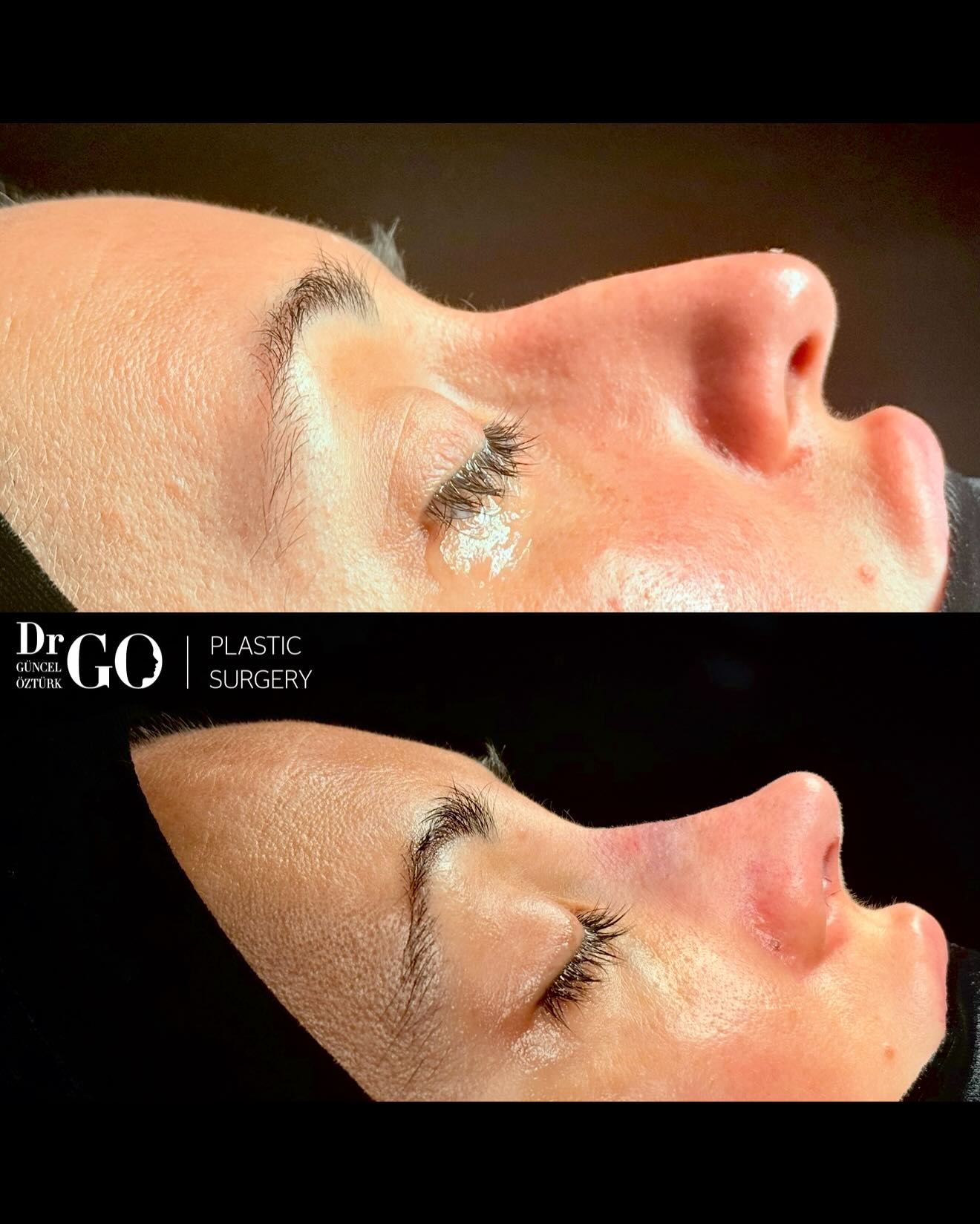
Weeks 1 to 2: Swelling and Protection
During the first week, the nose looks fuller. The bridge may appear higher, the tip rounder, and the profile softer than expected. This is normal. Swelling is protective, it’s your body holding space while tissue adjusts.
Breathing may feel different. Congestion is common. Small daily improvements matter more than big ones. You’ll have follow-ups in the clinic to remove the splint and check airflow. This part feels like settling in, not finishing.
Weeks 3 to 8: Shape Begins to Show
Around one month, people start to see glimpses of the nose’s future shape. The bridge softens. The tip becomes less swollen. Movement feels easier.
But the result is still early. Think: sketch before final drawing. You’ll likely notice changes from week to week. This is expected.
Months 3 to 6: The Nose Finds Its Balance
This is the period when the nose starts to look “like you”. Expressions look natural again.
Swelling is now subtle rather than global.
Friends may say things like: “You look rested” or “Your face looks balanced somehow”. They may not identify the nose as the change. That’s the goal.
Months 6 to 12: Final Refinement
Deep tissue settles slowly. The tip defines. Contours sharpen or soften depending on your anatomy. This is when the full harmony appears.
Assoc. Prof. Dr. Güncel Öztürk: “A natural rhinoplasty is one that blends into the face so quietly that others can’t point to what changed. They just feel the balance.”
How to Support Your Healing
- Avoid comparing your progress to others
- Limit mirror checking to once or twice a day
- Stay in contact with your surgeon or coordinator
- Keep routines simple
- Let changes unfold in their own time
When you know what to expect, the process feels less like waiting and more like unfolding.
The final shape is not new you. It’s you, with more quiet balance.
Risks, Red Flags, and When to Pause
This section is not here to create fear. It is here to help you feel steady. When people run into problems with rhinoplasty in Turkey, it usually starts before surgery, in the choosing stage, not in the operating room. These are signs to notice early.
Prices That Seem Strangely Low
If a price is far below the usual Istanbul range, something has been removed. Often that missing part is:
- The surgeon’s direct involvement
- Time spent on planning
- Safe hospital conditions
- Clear follow-up
Low cost can look helpful at first, but it often means limited guidance when you need it most.
No Clear Surgeon Identity
If the clinic speaks about the “team”, or the “doctor’s group”, but does not give you one surgeon’s full name, pause. You are not paying for a clinic name. You are trusting a pair of hands and a way of thinking.
A real surgeon is:
- Easy to look up in the Ministry of Health registry
- Listed on Turkish Society of Plastic Reconstructive and Aesthetic Surgeons
- Comfortable speaking with you before booking
If a clinic avoids giving a name or gives only initials, step back.
Pressure to Book Quickly
If someone says: “Only a few spots left” or “Price changes tomorrow”, that is not medical care. Your nose and breathing are not a limited-time offer.
A calm surgeon speaks slowly. A thoughtful clinic gives you time.
Promises of Instant Results
Rhinoplasty changes settle over months, not days. If someone says you’ll look “finished” in one week, the explanation is not realistic.
Assoc. Prof. Dr. Güncel Öztürk: “Healing has pace. When expectations are honest from the start, the process feels clearer and lighter.”
When to Pause
Stop and reassess if:
- Communication feels rushed
- You feel unsure and cannot explain why
- The clinic avoids simple questions
- You are being asked to decide before speaking to the surgeon
You don’t need to be afraid of surgery. You only need to move at a pace that feels calm and clear.
Wanna learn more about “How to Avoid Rhinoplasty Scams in Istanbul, Turkey“?
Travel & Legal Considerations for Rhinoplasty in Turkey
Planning your trip should feel steady, not rushed. Once you understand the basic, visas, clinic licensing, and patient rights, the process becomes clearer. This section keeps things simple and practical.
Visa and Entry Requirements
Most travelers enter Turkey visa-free or with a quick e-Visa that takes only a few minutes online. This includes visitors from EU Schengen countries, UK, Gulf countries, Many Latin American and Asian countries. You can check your exact status on dtvgroup.com.tr. If your country requires a visa, it’s typically granted for 90 days of stay.
Use the same passport you used to apply for the e-Visa when entering Turkey. (Yes, some travelers forget this part.)
Travel Logistics to Keep Things Smooth
- Plan to stay in Istanbul 7–14 days depending on the procedure.
- Choose a hotel near the clinic, not across the city.
- Arrange airport transfers before arrival.
- Keep medication and medical papers in your carry-on, not checked luggage.
- Avoid booking sightseeing tours during the first week, your body’s energy is going to healing.
Insurance Considerations
Standard travel insurance often does not cover elective surgery. Some clinics offer optional surgical complication coverage. If peace of mind matters to you, ask about it early in the conversation.
Airport Transfers & Post-Surgery Travel Restrictions
Reputable clinics provide airport pickup and drop-off, often in VIP vehicles with English-speaking drivers.
After surgery, avoid heavy luggage and allow 7–9 days in Istanbul for proper recovery and follow-up. Airlines typically permit flying after splint removal, but it’s best to get written clearance from your surgeon.
Legal Protections for Medical Tourists
While Turkish clinics are regulated by the Ministry of Health, there’s limited legal recourse for foreign patients if complications arise after returning home.
- Choose licensed and accredited clinics
- Ask for a written consent form outlining risks, outcomes, and revision policies
- Keep all documentation, including invoices, prescriptions, and before-after images
Language Support & Contracts
Most top rhinoplasty clinics in Istanbul offer bilingual contracts and have English-speaking staff. Still, ask for translations of all key documents, especially pre-op consent forms and post-op care instructions.
Common Patient Questions: Rhinoplasty in Turkey
These are the questions people ask most often.
Is it safe to get a rhinoplasty in Turkey?
Yes, provided you choose a licensed clinic and board-certified surgeon. Istanbul is a hub for medical tourism with hospitals that meet international standards. Clinics treating international patients are often accredited and follow strict protocols.
How long should I stay in Istanbul after rhinoplasty?
Most people stay 7 to 10 days after primary rhinoplasty, and 10 to 14 days for revision cases. This allows time for splint removal, swelling checks, and flight clearance. Leaving too early can make recovery uncomfortable.
Will I be in pain?
Most describe the feeling as fullness or pressure, not sharp pain. Congestion is more common than discomfort. Medication and rest usually keep things manageable. You don’t need to be strong, you just need to be gentle with yourself.
What’s the difference between open and closed rhinoplasty?
Open involves a small incision at the columella and offers more visibility for complex work. Closed is performed inside the nostrils and leaves no external scar. Both have pros and cons depending on your anatomy and goals.
Does rhinoplasty hurt?
Most patients describe discomfort, not pain. You may feel pressure, congestion, or mild soreness for the first few days. Pain medications are included in all treatment packages.
Can I travel alone?
Yes, many people do. The first day is easier with someone present, but if you travel solo, clinics are used to guiding patients step by step. Coordinators usually stay in close contact through messages and check-ins.
How do I clean my nose after surgery?
Your clinic will show you how to use gentle saline spray and avoid direct pressure. No heavy blowing or squeezing. This is about patience, not effort. The inside heals slowly and should not be rushed.
When can I exercise again?
Light walking is encouraged early. Gym activity is usually paused for 4 to 6 weeks depending on swelling and breathing. Your surgeon will give timing based on how your body responds, not a fixed schedule.
What if swelling lasts longer than expected?
Swelling settles gradually. Some people see more change in month three than month one. Thick skin or revision cases may take longer. If your surgeon confirms your healing is on track, there is no need to worry. Healing is not a race.
Can I combine rhinoplasty with other procedures?
Yes, sometimes. For example, eyelid surgery or chin contouring can be combined when appropriate. The decision depends on breathing needs, anesthesia time, and your overall health. This is something the surgeon decides with you, not the clinic coordinator.
What if I need revision surgery later on?
Good clinics offer free or discounted revisions if needed within 6–12 months. However, most patients are satisfied with the first result when selecting experienced surgeons.
Will people be able to tell I had surgery?
If the goal is balance, not dramatic change, the result often reads as “you look rested”, rather than “you changed your face”. A natural rhinoplasty blends with your features.
Will language be a barrier during my treatment?
Not at top clinics. Most have English-speaking coordinators, surgeons, and nurses. Translation support is often included in medical packages.
How do I know if a clinic is licensed?
Search the clinic on HealthTürkiye and confirm it holds an International Health Tourism Authorization Certificate. If it is not listed, do not move forward. This check takes less than two minutes.
What happens after I fly home?
Follow-up usually continues through:
- Photo check-ins
- Messaging support
- Occasional video calls
Recovery does not end when you leave Istanbul. A good clinic stays reachable.
Statistics & Trends: Rhinoplasty in Turkey
Turkey isn’t just leading the conversation on hair transplants anymore, it’s rewriting the rulebook on rhinoplasty, too. From natural “preservation rhinoplasty” to ultrasonic reshaping, Turkish surgeons now perform more nose surgeries per capita than any other country. And the numbers show why the world keeps flying in for it.
According to the International Society of Aesthetic Plastic Surgery (ISAPS, 2025 Global Survey), Turkey ranks #1 worldwide in rhinoplasty volume, performing an estimated 80,000–100,000 nose surgeries annually. That’s nearly 15% of all rhinoplasties globally, with Istanbul alone accounting for over half.
Patient Volume & Global Demand
- Around 1 in 3 foreign plastic surgery patients in Turkey come for rhinoplasty, according to USHAŞ (Türkiye International Health Services, 2025).
- Over 400,000 international visitors traveled to Turkey in 2025 for aesthetic facial surgeries, with rhinoplasty topping the list.
- Demand is especially high among patients aged 18–35, reflecting the global shift toward earlier, more subtle cosmetic interventions.
Turkey’s rhinoplasty boom is fueled by the combination of surgical artistry, advanced tools (like Piezotome ultrasonic systems), and post-op tourism comfort, patients recover in boutique hotels overlooking the Bosphorus, not in sterile wards.
Technique Trends & Innovations
Modern rhinoplasty in Turkey has moved far beyond the “one-size-fits-all” approach.
- Preservation Rhinoplasty: Now the gold standard, maintaining nasal cartilage for a softer, more natural look.
- Ultrasonic (Piezo) Rhinoplasty: Uses sound-wave technology to reshape bone with less trauma and swelling.
- Closed (scarless) Rhinoplasty: Accounts for over 65% of operations in 2026, especially among European and Gulf patients seeking subtle refinement.
- Functional + Aesthetic Hybrid Surgeries: Around 40% of Turkish rhinoplasties also correct breathing or septum issues simultaneously.
According to Journal of Plastic, Reconstructive & Aesthetic Surgery (2025), patients treated with ultrasonic rhinoplasty reported 30–40% less bruising and downtime than those who had conventional osteotomy methods.
Patient Satisfaction & Recovery Insights
A 2025 patient study by Turkish Aesthetic Surgery Society found:
- Average satisfaction rate: 94% among international rhinoplasty patients.
- Average recovery time: 8–12 days before return to normal routine.
- Complication rate: Below 3%, compared to global average of 6%.
- Main motivation: 61% cited “confidence boost,” 22% wanted “natural harmony,” and 17% sought functional improvement.
Outlook for 2026–2027
Rhinoplasty in Turkey is moving from “affordable cosmetic” to “artistic precision”. The next wave includes:
- AI-based 3D nasal planning to predict facial balance outcomes.
- Stem-cell and exosome-assisted healing to reduce swelling and accelerate recovery.
- Custom implants and cartilage scaffolds for revision or reconstructive cases.
The Forbes Health 2025 report forecasts that Turkey’s rhinoplasty segment will exceed $700 million USD in 2026, solidifying its place as the most sought-after plastic surgery in Europe and the Middle East.
By 2026, Rhinoplasty in Turkey has become more than a trend, it’s a model of medical artistry that balances science, aesthetics, and empathy. Patients no longer travel just for a new nose, they come for a result that feels like it was always meant to be there.
References & Sources
- Turkish Ministry of Health – International Health Tourism Authorization Registry
- USHAŞ (International Health Services Inc.) – Medical Tourism Coordination & Standards
- Turkish Society of Plastic, Reconstructive and Aesthetic Surgeons (TSPRAS)
- International Society of Aesthetic Plastic Surgery (ISAPS) – Global Procedure Statistics
- International Society of Hair Restoration Surgery (ISHRS) – Patient Safety & Surgeon Directory
- American Society of Plastic Surgeons (ASPS) – Rhinoplasty Clinical Insights & Guidelines
- Society for Plastic Surgery (EPRS / EBOPRAS) – European Board Certification Standards
- World Health Organization (WHO) – Health System Structure & Cross-Border Care Reports
- Joint Commission International (JCI) – Hospital Accreditation Standards
- Turkish Statistical Institute (TÜİK) – Health Tourism Revenue Data
- Civil Aviation Authority of Turkey – Flight Access to Istanbul & Medical Travel Facilitation
- Peer-Reviewed Medical Research on Rhinoplasty Recovery Timelines
- Rohrich RJ, Menick FJ. “Essentials of Primary Rhinoplasty.” Plastic and Reconstructive Surgery Journal.
- Daniel RK. “Rhinoplasty: Anatomic Revision & Structural Grafting.” PRS Global Open.
- Medical Travel Market Reports (Global Growth Projections) – Coherent Market Insights: Turkey Medical Tourism Market Outlook 2025–2032.
